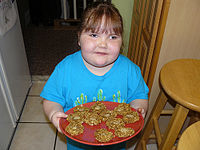
Photo from wikipedia
Pediatric sleep-related hypoventilation is a clinical pattern in which ventilatory insufficiency occurs in the setting of either severe OSA (obstructive hypoventilation) or obesity hypoventilation (sleep related hypoventilation). We are reporting… Click to show full abstract
Pediatric sleep-related hypoventilation is a clinical pattern in which ventilatory insufficiency occurs in the setting of either severe OSA (obstructive hypoventilation) or obesity hypoventilation (sleep related hypoventilation). We are reporting a case describing the management of overlapping obstructive hypoventilation due to uncontrolled severe OSA and pediatric obesity hypoventilation syndrome. The patient is a full term African American 5 y/o male with past medical history of obesity and prediabetes who was referred to discuss sleep related problems after rapid onset of weight gain.He gained 76 lbs over 8-month period; during this time his aunt noticed apneic events with the development of loud snoring.Initial workup was negative for abnormal findings,MRI w/w/o was unremarkable and TSH, cortisol, GH, IGF-1 and prolactin were all within normal limits. X-ray bone age study showed skeletal age appropriate for patient's chronologic age.Upper airway exam showed severe tonsillar hypertrophy 3+ with Mallampati class 4.The diagnostic PSG demonstrated the presence of 12 obstructive, 151 central, and 61 mixed apneas.There were 214 hypopneas resulting in an Apnea\Hypopnea Index of 60.5 events per hour.Mean oxygen saturation was 91.3%.The lowest oxygen saturation during sleep was 64.0%.Time spent ≤88% oxygen saturation was 119.7 minutes (26.2%). End tidal CO2 range was between 50-100 mmHg for 30% of study.The titration study revealed that the optimal treatment modality was BiPAP ST. This case focuses on a five-year-old male who experienced rapid onset weight gain and presented with snoring, excessive daytime sleepiness and apneic events and was found to have profound hypoventilation with hypopnea predominant severe obstructive sleep apnea.The initial differential diagnosis of pediatric sleep-related hypoventilation includes ROHHAD, congenital central hypoventilation syndrome, primary central sleep apnea and obesity hypoventilation syndrome.The most common cause of hypoventilation during sleep in children remains OSA.The stepwise approach to management in such a case includes tonsillectomy with adenoidectomy,along with use of BiPAP. After the T&A the patient should have repeat PSG with capnography, if hypercarbia persists on post procedure PSG, he will need to continue BiPAP therapy with appropriate weight loss program. Early recognition evaluation, and treatment of obstructive sleep apnea in the pediatric population is imperative to prevent long-term consequences.
Journal Title: SLEEP
Year Published: 2023
Link to full text (if available)
Share on Social Media: Sign Up to like & get
recommendations!